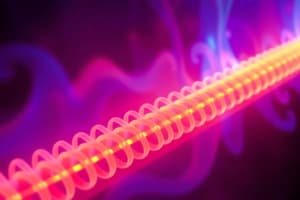Podcast
Questions and Answers
What is thermal equilibrium?
What is thermal equilibrium?
- When heat flows from a cooler object to a warmer object
- When two objects have the same temperature (correct)
- When heat is evenly distributed in a single object
- When heat does not transfer between two objects
Which material is considered a good conductor of heat?
Which material is considered a good conductor of heat?
- Rubber
- Feathers
- Wool
- Metals (correct)
What is conduction?
What is conduction?
- Transfer of heat through electromagnetic rays
- Transfer of heat through fluids
- Transfer of heat caused by temperature differences
- Transfer of heat by direct contact in solids (correct)
What causes convection currents in a fluid?
What causes convection currents in a fluid?
How is heat transferred from the sun to the Earth?
How is heat transferred from the sun to the Earth?
Which of the following is a characteristic of insulators?
Which of the following is a characteristic of insulators?
During which process does heat travel in a cycle through moving fluids?
During which process does heat travel in a cycle through moving fluids?
What happens when you touch hot sand with your feet?
What happens when you touch hot sand with your feet?
Flashcards are hidden until you start studying
Study Notes
Heat Transfer Mechanisms
- Heat flows from warmer to cooler areas due to temperature differences.
- Thermal equilibrium occurs when heat transfer continues until two objects achieve equal temperature.
- An example of thermal equilibrium is the heat exchange between a kettle and the surrounding air until they reach the same temperature.
Conduction
- Conduction is the transfer of heat through direct contact of particles in a solid.
- When your feet touch hot sand, the heat conducts from sand to skin, demonstrating conduction.
- Good conductors, such as metals, have densely packed particles that facilitate efficient heat transfer.
- Insulators, like feathers, wool, and rubber, resist heat transfer, serving to maintain temperature or prevent heat flow.
Convection
- Convection involves heat transfer in fluids (gases and liquids) prompted by changes in density.
- Hotter, less dense fluids rise, while cooler, denser fluids sink, creating convection currents.
- Boiling water demonstrates convection: heated water near the burner rises, displacing cooler water, which sinks to be heated in turn.
- Baseboard heaters distribute heat in a room through convection currents in the air.
Radiation
- Radiation enables heat transfer through empty space via electromagnetic waves without requiring matter.
- Thermal radiation travels at the speed of light in straight lines.
- The sun transfers heat to Earth through thermal radiation, traveling through the vacuum of space.
- Heat from a fire warming hands is also a result of thermal radiation.
Studying That Suits You
Use AI to generate personalized quizzes and flashcards to suit your learning preferences.




